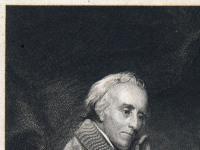One of the most difficult concepts for students to grasp when studying the Yellow Fever epidemic of 1793 is why Philadelphia’s doctors—among the most accomplished in North America—failed to understand the disease’s origin and method of transmission. Even worse (and even more perplexing), some doctors prescribed treatments such as blood-letting, which may have proven as toxic to patients as Yellow Fever itself.
This lesson uses primary sources owned by the Library Company of Philadelphia and the Historical Society of Pennsylvania to help students explore the complexities of medical thought in late eighteenth-century Philadelphia. The sources require students to use critical thinking skills to analyze why Philadelphians in 1793 managed the Yellow Fever epidemic the way they did—and empathize with the city’s political leaders, doctors, Yellow Fever patients, and victims.
The figure of Dr. Benjamin Rush, prominent Founding Father and early America’s most famous doctor, looms large over the response of the city of Philadelphia and its vibrant medical community to the scourge of Yellow Fever. Rush’s extreme treatment methods, centering on purging the body via bloodletting and vomiting, eventually earned criticism from some of his peers, who doubted the methods’ effectiveness. Much scholarly debate has focused on how culpable modern historians should hold Rush for not noticing the ill effects of his treatments, versus how much historians should laud him for his unwavering commitment to Philadelphia during one of the city’s darkest hours.
Rush and the eighteenth-century Anglo-American medical establishment operated under diverse theoretical perspectives about the causes and cures of diseases. Some of the theories were grounded in ancient scholarship. Galen’s humoral theory, for example, held that illnesses were caused by imbalances among four bodily fluids: blood, phlegm, black bile, and yellow bile. Restoration of proper humoral balance restored health. Doctors who embraced the humoral perspective studied fluids such as urine, vomit, and blood for signs of health, and prescribed treatments they hoped would influence the character of those fluids. Indeed, in an era before modern methods of peering into the human body (X-ray, for example), the body’s output was the only means of assessing its internal condition.
Rush was trained to practice medicine in academic and professional environments that embraced humoral theory. Given this context, it is unsurprising that he looked to purging as the basic treatment for Yellow Fever. And yet, despite the fact that many of Rush’s patients did recover from both Yellow Fever and the doctor’s purgings, reports on patient symptoms and treatment results might have raised serious doubts in the doctor’s mind about the effectiveness of his methods. Other medical practitioners, including many of Rush’s peers in the College of Physicians of Philadelphia, openly questioned his treatments. French physicians with greater experience managing Caribbean Yellow Fever outbreaks through palliative (i.e. noninvasive) treatment methods proposed and implemented their alternative treatments in the beleaguered city, to some effect. These undercurrents of disagreement did not shake Rush’s confidence in his own practice, however. If anything, he dug in his heels against his peers’ dissent. Firmly committed to the health and wellbeing of his patients, Rush treated Yellow Fever the best way he knew how. Why did Rush manage his cases the way he did?
Grounded in laboratory science and clinical testing, mainstream modern medical practice has by and large abandoned precepts that governed treatment in the eighteenth century, including humoral theory. Yet modern observers ought not to judge Rush too quickly for his efforts. This lesson encourages students to engage with the multifaceted character of Benjamin Rush on the doctor’s own terms, by working with letters Rush’s patients wrote to him asking for assistance during the Yellow Fever epidemic. After a brief introduction to issues surrounding Yellow Fever diagnosis and treatment, students will hone their historical thinking skills by seeking to understand the perspective of Benjamin Rush as he met with and treated Yellow Fever patients. They will read letters Rush received during the outbreak, record observations and conclusions based on those primary sources, synthesize their findings, and understand the pitfalls of reaping anachronistic judgment on historical characters using modern scientific knowledge people in the past lacked.


